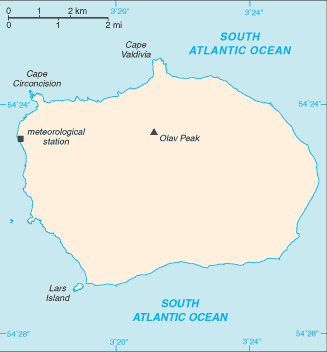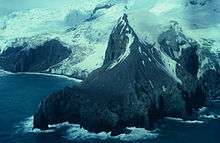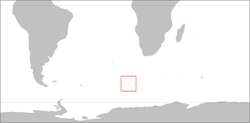Bouvet Island
Bouvet Island is an uninhabited 58.5 km² volcanic, mostly inaccessible, island in the Southern Ocean, south-southwest of the Cape Town. It is thought to be the most remote island in the world. The nearest land is Queen Maud Land, Antarctica, which is over 1,750 km (1,090 mi) away to the south. It is a dependency of Norway.
Understand

This uninhabited volcanic island was discovered in 1739 by a French naval officer after whom the island was named. No claim was made until 1825 when the British flag was raised. In 1928, the UK waived its claim in favor of Norway, which had occupied the island the previous year. In 1971, Bouvet Island and the adjacent territorial waters were designated a nature reserve. Since 1977, Norway has run an automated meteorological station on the island.
It's not too hard to get a lot of search-engine-hits for airports, hotels, rental cars, or even airport limousines at Bouvet Island, even though there have never been, and likely never will be, such things.
Landscape
It is a small (58.5 km²) volcanic island that rises sharply from the ocean, with cliffs up to 500 m high. Almost all of the island is covered by a thick glacier. The highest point is Olav Peak at 780 m.
Get in
Since the entire island is a nature reserve, it's likely that you will be denied permission, if the purpose of entering is just tourism, although usually you won't find anybody from the Norwegian immigration office on the island to refuse your entry. But if you absolutely have to get there anyway, your best bet is to try to find out when the next research expedition is scheduled to get there, and ask if you can join them. If you have a useful occupation or skill, such as Arctic research biologist, research geologist, helicopter pilot, or physician, you will probably be welcome. There's been at least one case of this happening in the past, when a bunch of radio amateurs were allowed to enter the island for a DXpedition (setting up an amateur radio station there to communicate with people around the world).
By boat
Bouvet Island is approximately 2,600 km (1,600 mi) south-southwest of the coast of South Africa.
There is nothing even remotely usable as a harbor, although it is possible to anchor outside of it. If you are willing to put your life at risk, you might try using a light boat with outboard engine to enter. It has been known to work, but plenty of people have tried and decided it was not worth the risk.
By plane
A safer way is to use a helicopter starting from a ship due to the rough seas surrounding the island.
Get around

The interior of the island is inaccessible.
Buy
There is no economic activity on Bouvet Island. Any expedition to this place would need to be fully provisioned before you leave.
Sleep
There are no accommodations on Bouvet Island. The only permanent structure is an automated weather station.
Connect
For some obscure reason the Internet Assigned Numbers Authority gave it its own top-level domain .bv (even though it is very unlikely that anyone will ever actually live there). Because of this, Norway - the country that administers the domain - has decided that the .bv domain will remain unused.
